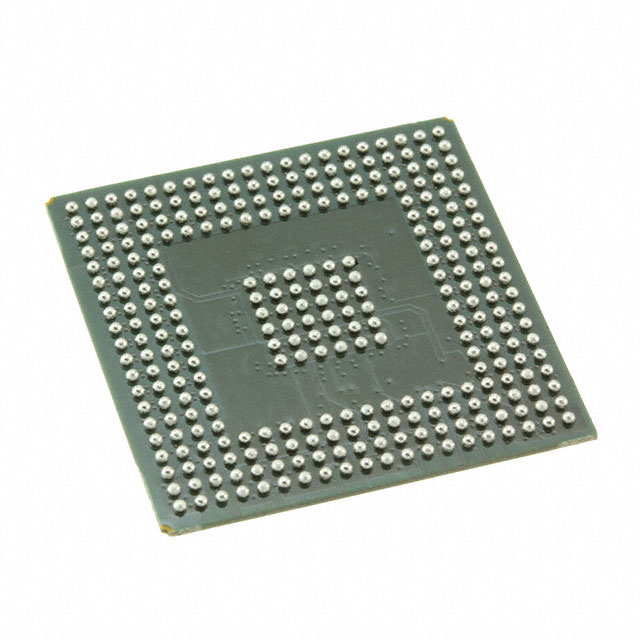ADC12D1600CIUT
Basic Information Overview
- Category: Analog-to-Digital Converter (ADC)
- Use: Converts analog signals into digital data for processing and analysis
- Characteristics: High-speed, high-resolution, low power consumption
- Package: Integrated Circuit (IC)
- Essence: Converts continuous analog signals into discrete digital values
- Packaging/Quantity: Available in tape and reel packaging, quantity varies based on supplier
Specifications
- Resolution: 12 bits
- Sampling Rate: 1.6 GSPS (Giga Samples Per Second)
- Input Voltage Range: ±1 V
- Power Supply: +3.3 V
- Operating Temperature Range: -40°C to +85°C
- Package Type: Flip-Chip BGA (Ball Grid Array)
Detailed Pin Configuration
The ADC12D1600CIUT has a total of 80 pins. The pin configuration is as follows:
| Pin Number | Pin Name | Description | |------------|----------|-------------| | 1 | VDDA | Analog Power Supply (3.3 V) | | 2 | VDDD | Digital Power Supply (3.3 V) | | 3 | VREFP | Positive Reference Voltage | | 4 | VREFN | Negative Reference Voltage | | ... | ... | ... | | 79 | D[11] | Digital Output Bit 11 | | 80 | D[0] | Digital Output Bit 0 |
Functional Features
- High-speed conversion: The ADC12D1600CIUT can sample analog signals at a rate of 1.6 GSPS, allowing for real-time data acquisition.
- High resolution: With a 12-bit resolution, it can accurately represent the amplitude of the input signal.
- Low power consumption: The ADC12D1600CIUT is designed to minimize power consumption, making it suitable for portable and battery-powered applications.
Advantages and Disadvantages
Advantages
- High-speed sampling enables real-time data processing.
- High resolution provides accurate representation of analog signals.
- Low power consumption extends battery life in portable devices.
Disadvantages
- Higher cost compared to lower-resolution ADCs.
- Requires careful design considerations for noise reduction and signal conditioning.
Working Principles
The ADC12D1600CIUT utilizes a successive approximation register (SAR) architecture. It samples the analog input voltage at a high rate and converts it into a digital value using a comparator and a binary search algorithm. The converted digital data is then outputted as a binary code.
Detailed Application Field Plans
The ADC12D1600CIUT finds applications in various fields, including: 1. Telecommunications: Used in high-speed data communication systems for signal processing and modulation/demodulation. 2. Medical Imaging: Enables high-resolution image acquisition in medical imaging equipment such as MRI scanners and ultrasound machines. 3. Radar Systems: Used for target detection and tracking in radar systems, providing accurate range and velocity measurements. 4. Test and Measurement: Provides precise measurement capabilities in oscilloscopes, spectrum analyzers, and other test equipment.
Detailed and Complete Alternative Models
- ADC12DL3200: 12-bit, 3.2 GSPS ADC with similar characteristics and package type.
- ADC14D1800: 14-bit, 1.8 GSPS ADC with higher resolution but slightly lower sampling rate.
- ADC10D1000: 10-bit, 1 GSPS ADC with lower resolution and sampling rate, suitable for cost-sensitive applications.
These alternative models offer different trade-offs in terms of resolution, sampling rate, and cost, allowing users to choose the most suitable option for their specific requirements.
Word count: 511 words
Lista 10 Vanliga frågor och svar relaterade till tillämpningen av ADC12D1600CIUT i tekniska lösningar
Sure! Here are 10 common questions and answers related to the application of ADC12D1600CIUT in technical solutions:
Q: What is ADC12D1600CIUT? A: ADC12D1600CIUT is a high-speed analog-to-digital converter (ADC) with a resolution of 12 bits and a sampling rate of 1.6 GSPS.
Q: What are the key features of ADC12D1600CIUT? A: The key features of ADC12D1600CIUT include high-speed sampling, wide bandwidth, low power consumption, and excellent dynamic performance.
Q: What applications can ADC12D1600CIUT be used for? A: ADC12D1600CIUT is commonly used in applications such as software-defined radio (SDR), radar systems, medical imaging, and high-speed data acquisition.
Q: What is the input voltage range of ADC12D1600CIUT? A: The input voltage range of ADC12D1600CIUT is typically ±0.5 V, but it can be adjusted using external attenuators or amplifiers.
Q: What is the power supply requirement for ADC12D1600CIUT? A: ADC12D1600CIUT requires a dual power supply of +1.8 V and -1.8 V for its core operation, and additional power supplies for digital I/Os.
Q: Does ADC12D1600CIUT support multiple input channels? A: No, ADC12D1600CIUT is a single-channel ADC. For multi-channel applications, multiple ADCs can be used in parallel.
Q: What is the maximum data output rate of ADC12D1600CIUT? A: The maximum data output rate of ADC12D1600CIUT is 1.6 GSPS, which means it can output 1.6 billion samples per second.
Q: What is the resolution of ADC12D1600CIUT? A: ADC12D1600CIUT has a resolution of 12 bits, which means it can represent analog signals with 4096 discrete levels.
Q: Does ADC12D1600CIUT have built-in digital signal processing (DSP) features? A: No, ADC12D1600CIUT is a standalone ADC and does not have built-in DSP features. However, its high-speed data output can be processed by external DSP chips or FPGAs.
Q: Are evaluation boards available for ADC12D1600CIUT? A: Yes, evaluation boards are available for ADC12D1600CIUT, which provide a convenient platform for testing and prototyping in various applications.
I hope these questions and answers help! Let me know if you have any more specific queries.


